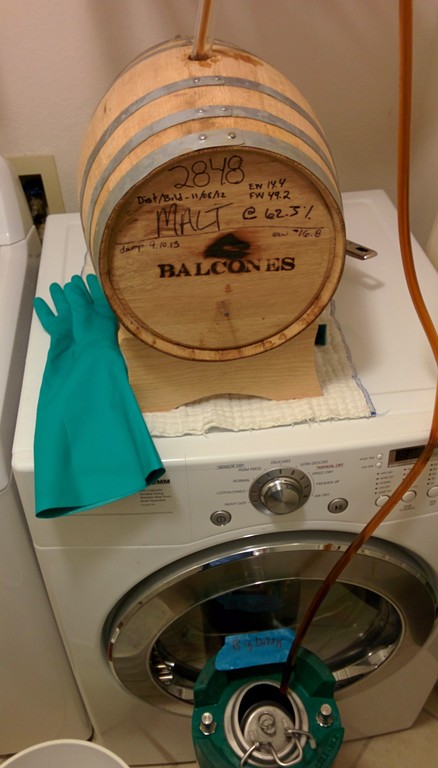This week at Woxford, we’re bottling 15 gallons of barrel-aged beer. A barleywine which spent nearly 4 months in a Balcones Blue-corn whiskey barrel will fill about 26 750mL bottles. The second barrel, an 11 gallon Rum barrel filled with Makkurokurosuke RIS will be transferred into approximately fifty 750mL bottles. The replacements have been brewed and fermented at this point; now just to swap contents and wait a bit more.
You may have noticed it’s been about a month since the last brew session. That may be more typical as the home schedule is filling up. That got me thinking about what sort of beers and ingredients I wanted to focus on given that the frequency of brewing is going to slow down. Recently we’ve been testing out new yeasts and blends and I want to see about doing a bit more of that, but with a single yeast blend. This blend includes saison Saccharomyces, some brett, and quite a bit of souring bacteria. The fun part is learning how to use both to get the beer to be just right. The tools are fairly simple: hops, temperature and time.
Larger amounts of hops will inhibit the growth of the souring bacteria. Higher temps will favor Saccharomyces, even though lactobacillus can handle and prefers high temp, sacc will out-compete and dominate. Lower temperatures, while not the best for souring bacteria, will favor a more sour beer due to the sluggishness of Saccharomyces at lower temps.
This is the hypothesis, with quite a bit of anecdotal material (in the form of really good beer) to back those assertions. But, the proof, as they say, is in the pudding. $240 worth of pudding.

Drinking Jester King’s Le Petit Prince, 2.8% Farmhouse Table beer. Excellent working beer. Look at all of those 750mL bottles.
This recipe will be the second farmhouse sour recipe. The first resulted in solid, but not sour saison. The Farmhouse Saison Experiement still need a proper review, but the result was a bit one dimensional despite using four different strains of Brett. The effort did help confirm that one cannot kettle sour a beer in an aluminum pot beyond about 3.8 pH. Bizarre!
For this recipe, I’ll split the wort post-boil and run two different fermentation schedules. The first, will be held between 55F and 60F to simulate a brew in the winter time (Texas) where the average temperature is lower. The hypothesis suggests this should produce a more sour final product. The second half will use a more typical saison schedule, starting around 65F, holding for 24 or 48 hours and then ramping up (and/or letting free-rise) until fermentation is complete.
The final products will be compared and contrasted. I may end up blending them in the end as well. In any case, this should be pretty exciting. Note the recipe says Wyeast 3711 for yeast, that’s the closest to Jester King Dregs, but it’s not the same (and certainly doesn’t contain the souring bus).
Recipe Details
| Batch Size | Boil Time | IBU | SRM | Est. OG | Est. FG | ABV |
|---|---|---|---|---|---|---|
| 12 gal | 90 min | 19.7 IBUs | 3.5 SRM | 1.052 SG | 1.007 SG | 6.0 % |
Style Details
| Name | Cat. | OG Range | FG Range | IBU | SRM | Carb | ABV |
|---|---|---|---|---|---|---|---|
| Saison | 16 C | 1.048 - 1.065 | 1.002 - 1.012 | 20 - 35 | 5 - 14 | 2.3 - 2.9 | 5 - 7 % |
Fermentables
| Name | Amount | % |
|---|---|---|
| Pilsen (BestMälz) | 14 lbs | 59.57 |
| Wheat Malt, Ger | 9.5 lbs | 40.43 |
Hops
| Name | Amount | Time | Use | Form | Alpha % |
|---|---|---|---|---|---|
| Magnum | 0.18 oz | 90 min | Boil | Pellet | 12 |
| Goldings, East Kent (2011 Crop - Purchase FHBW 20130220) | 1.94 oz | 30 min | Boil | Pellet | 5.6 |
| Willamette | 1.94 oz | 5 min | Boil | Pellet | 4.3 |
| Crystal | 1.94 oz | 1 min | Boil | Pellet | 3 |
| Citra | 2 oz | 3 days | Dry Hop | Pellet | 14.4 |
| Styrian Goldings | 2 oz | 3 days | Dry Hop | Pellet | 3 |
Yeast
| Name | Lab | Attenuation | Temperature |
|---|---|---|---|
| French Saison (3711) | Wyeast Labs | 80% | 65°F - 77°F |
Notes
| Split into two 6G containers 1. Hold at 57F 2. Pitch at 65F, and ramp up to 80F over 7 days Blend batches later. |
Download
| Download this recipe's BeerXML file |

